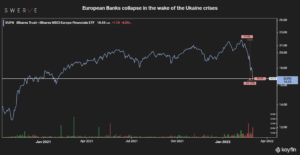The risk of deplatforming Russia
You can’t forcibly remove a G20 country from the global financial system without expecting serious repercussions for all participants. Over a week or so, approximately a trillion dollars in Russian reserves, equities and bonds have effectively disappeared from the system. Europe and the Eurozone are most at risk and markets have responded accordingly by wiping off all 2021’s gains.

You can’t forcibly remove a G20 country from the global financial system without expecting serious repercussions for all participants. Over a week or so, approximately a trillion dollars in Russian reserves, equities and bonds have effectively disappeared from the system. Europe and the Eurozone are most at risk and markets have responded accordingly by wiping off all 2021’s gains. European banks lead the decline with a 24% collapse from the recent highs (see chart) as Italian, French and German banks hold approximately two thirds of total Russian debt. The flip side of the same coin is gold going vertical and approaching the $2,000 level. It will take weeks, possibly months, to fully appreciate the balance sheet damage for the multitude of investors who are holding Russian assets either as investment or collateral. As we learnt from the 2008 crisis, it is impossible to map out the extent of global counterparty risk. The only certainty is that the aggregate effect of financial, economic and geopolitical repercussions of the Ukraine crisis will not only further feed into inflation but also tip the economy into recession by or before the end of the year. In the face of the ensuing stagflationary environment, more geopolitical instability is to be expected. Policy makers will have no other choice but to deploy ever more extreme and novel (think “CBDCs”) forms of monetary and fiscal actions. Not a good scenario for investors as the bulk of the approximately $500 trillion traditional financial assets (cash, credit and equities) will either be debased or impaired in their ability to generate returns on a real basis. Sovereign instability will continue to be a feature of this decade and astute investors may want to fully rethink their portfolio in terms of managing historically elevated counterparty and custodian risks. The best institutional grade safe haven investments and jurisdictions will strive. (Disclosure: Hold all assets mentioned. Not investment advice. Do your own research)